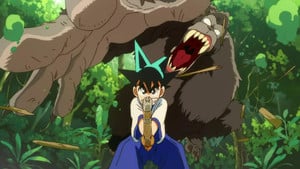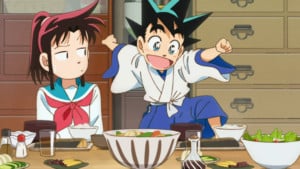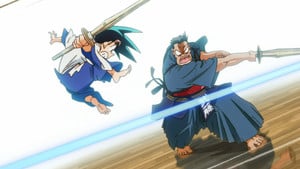The Spring 2025 Anime Preview Guide
Yaiba: Samurai Legend
How would you rate episode 1 of
Yaiba: Samurai Legend ?
Community score: 3.8
What is this?

Yaiba Kurogane has spent his days training in the jungle to attain his goal of becoming a real samurai. By a twist of fate, he returns to Japan and starts living with the Mine family, who are connected to his father, Kenjuro. Yaiba constantly baffles the Mines' daughter Sayaka as she witnesses his wild and reckless ways. One day, Yaiba tags along with Sayaka to school and has a fateful encounter with Takeshi Onimaru, a kendo expert. Yaiba and Onimaru repeatedly clash, and as if in response to their search for strength, two ancient powers are unleashed: the Fujinken, the Wind God's Sword, and the Raijinken, the Thunder God's Sword. Both supernatural blades that have jolted the world since ancient days have reawakened...and the truth behind them is revealed!
Yaiba: Samurai Legend is based on the Yaiba manga by Gōshō Aoyama. The anime series is streaming on Netflix and Hulu on Saturdays.
How was the first episode?

Rating:
Hey, remember when shonen anime was fun? Yaiba: Samurai Legend is based on a shonen series that's almost as old as I am, which is, by anime fan standards, old as balls. It's also from Gōshō Aoyama, now better known the world over as the creator of Detective Conan, aka Case Closed.
I'm unfamiliar with the source material, but from what I can tell, Wit Studio made little, if any, effort to modernize it. In many ways, this is a good thing! It's got the goofy kids' series energy that makes sense for a story originally aimed at ten-year-olds, with silly animal mascots, slapstick comedy, and a brash young protagonist. I probably shouldn't be surprised that the character designs haven't been modernized at all, considering Aoyama's art style is a huge selling point to modern audiences who only know him from Conan – and I'm including myself in that group. The only element that doesn't feel straight out of the '80s is the modern animation techniques WIT uses to create punchy, well-choreographed action further livened up by the camera swerving about. They even brought back Minami Takayama to play Yaiba.
Most importantly, there's a joy in the weirdness of a young child who was raised as a samurai in the middle of the jungle that's hard to replicate in fully modern works. A banana conveyor belt? Sure! A child, an adult man, and a tiger accidentally getting packed into a box and shipped to Tokyo without ever being found? I don't see why not! I was so swept up in its silliness that I didn't even stop to question why there were tigers and gorillas in the same place.
But there's one thing about shonen that's best left in the '90s, and that's how female characters were written. The male characters were lots of fun; Yaiba's dad feels like he could have been the protagonist of his own series back in the day, though part of that may be Katsuyuki Konishi bringing some Kamina energy to his performance. But Sayaka, the obligatory female sidekick and likely future love interest, has a personality I can only describe as “girl.” She's a stick in the mud, put out by Yaiba doing things like, uh, lifting her skirt and rubbing himself all over her friends. She has no power or skill of her own other than being the prim civilizer to Yaiba's feral nature. Modern gender relations may not be perfect, but we've come a long way in the last 36 years.

Rating:
It's interesting to think that there were two manga about boys raised to be feral by oddball dads coming out at the same time. Rumiko Takahashi's Ranma ½ predates Gōshō Aoyama's Yaiba by one year, but the two share a couple of remarkable similarities – namely that in both series, a girl is forced to live with a boy who doesn't quite know how to function. In Yaiba's case, that's because his dad apparently raised him in a jungle somewhere with zero contact with the modern world. All Kenjuro appears to have taught his son is “how to be a samurai,” albeit with a definition of “samurai” that may not hold water historically. Yaiba's special attack is to turn his back on his enemy, something I was under the impression was considered bad form.
But that's just part and parcel of this zany story. Its most marked feature is its frenetic pace – events happen in rapid succession, and Yaiba himself almost never stops moving. Whether he's eating, walking, or fighting, there's always a piece of him that's going top speed. Even when he hoots at Sayaka in the locker room, he's in motion with at least one part of his body. It's easy to believe that he grew up having to sleep with one eye open.
It's also somewhat exhausting. This episode never gives us a moment to rest, flinging itself from one scene to the next with reckless abandon. The closest we come to having a breather is when Sayaka goes to meet her dad Raizo at the airport, a scene that's cut short when Yaiba and his dad show up fighting their way out of a crowd of security guards. (Maybe the biggest hint that this is based on an older manga series is the fact that they can get through airport security with two swords and a tiger.) From there, Kenjuro manages to dump Yaiba at Raizo's dojo before scarpering off to parts unknown, something Yaiba tells us he's used to. I wouldn't say Kenjuro makes Genma look like a good dad, but he's terrible in a different way.
The best part of this episode is how kinetic it is. The movements are fast, fluid, and consistent, with just the right amount of exaggeration to make them pull you in. The story isn't thus far grabbing me, but Aoyama's distinctive character designs work well with the material. It's solid shōnen action with a flavor of older days.

Rating:
If Yaiba: Samurai Legend existed in this modern, easily-accessible, and translated form when I was a wee lad of the '90s, I might just have made it my entire personality. I mean no disrespect to the original Yaiba adaptation from 1993, but I was only one year old then, and I didn't live in the Philippines, so this is my first proper introduction to Yaiba Kurogane and his hack-and-slash adventures. Besides, I have to imagine that Studio Wit is adding something unique to this version of the story with their brand of gorgeous, stylized spectacle.
My favorite thing about this premiere is how it captures the feeling of reading thrilling action-adventure comics as a kid. The vibrant colors, punchy choreography, and fluid animation all speak to how the scenes would come to life in your head, even if they just existed as static black-and-white panels on the page. Yaiba is a spunky little dude, after all, so his story should harness the innate power of adolescent playground imagination.
The way the story plays on the clash of old-fashioned samurai adventures and modern Japanese culture is very appropriate, too, given how much this anime feels like a synthesis of classic '90s vibes and modern aesthetics. Yes, I am probably the ideal mark for this kind of nostalgia bait, but just like the recent Urusei Yasura and Ranma ½ revivals, I think there is something to be said for injecting some of that classic comic-book goodness into our modern anime landscape. More spiky hair, I say! More goofy hijinks; more wacky cutaways to bulging eyeballs and frog-mouthed shock whenever our hero does something rascally.
For as much as Yaiba appeals to my inner child, I can't say whether or not the very kid-oriented storytelling and pacing will be something I can keep up with week after week for however many months this series is set to run. It will, however, make for a prime binge opportunity whenever I am at home with a cold and need something innately comforting and rejuvenating to recharge my batteries. More importantly, I can see this new version of Yaiba inspiring an all-new generation of children to fall in love with swashbuckling samurai cartoons. That right there means that Yaiba is doing the Lord's work.
discuss this in the forum (125 posts) |
this article has been modified since it was originally posted; see change history
back to The Spring 2025 Anime Preview Guide
Season Preview Guide homepage / archives